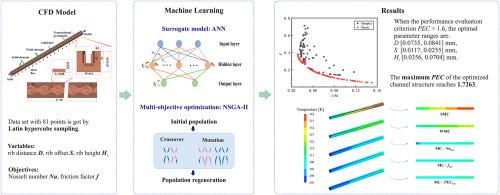基于神经网络辅助NSGA-II算法的多对双肋对称正弦波微通道多目标优化
IF 5
2区 工程技术
Q1 ENGINEERING, MECHANICAL
International Journal of Thermal Sciences
Pub Date : 2025-09-02
DOI:10.1016/j.ijthermalsci.2025.110250
引用次数: 0
摘要
微通道散热器为满足微电子元件日益苛刻的热管理要求提供了一种有效的解决方案。本研究提出在水力直径为0.2 mm的对称波状微通道中集成多个双肋结构。在进口雷诺数Re = 496下,选取三个设计变量:双肋横向距离(D∈[0,0.12]mm),双肋纵向距离(S∈[0,0.12]mm),肋高度(Hr∈[0,0.2]mm)。采用拉丁超立方体采样方法生成了81个样本,用于计算流体动力学模拟。根据仿真结果进行灰色关联分析,构建反向传播神经网络(BPNN)和遗传算法优化的BPNN (GA-BP)预测模型。采用非支配排序遗传算法II (NSGA-II)对Nusselt数(Nu)和摩擦因子(f)进行多目标优化。结果表明,三种结构参数均与Nu和f有较强的相关性,GA-BP在泛化能力和预测精度上均优于BPNN。通过NSGA-II得到的Pareto最优解集表明,当性能评价标准PEC >; 1.6时,最优参数范围为:D∈[0.0735,0.0841]mm, S∈[0.0117,0.0255]mm, Hr∈[0.0356,0.0704]mm,优化后通道结构的最大PEC达到1.7263。本文章由计算机程序翻译,如有差异,请以英文原文为准。

Multi-objective optimization of symmetric sinusoidal wavy microchannel with multiple pairs of dual-rib using neural network-assisted NSGA-II algorithm
Microchannel heat sinks provide an effective solution to meet the increasingly demanding thermal management requirements of microelectronic components. This study proposes the integration of multiple dual-rib structures in symmetric wavy microchannels with hydraulic diameter of 0.2 mm. Under the inlet Reynolds number Re = 496, three design variables are selected: the transverse distance of dual-rib (D [0, 0.12] mm), the longitudinal distance of dual-rib (S [0, 0.12] mm), and the height of ribs (Hr [0, 0.2] mm). Eighty-one samples are generated using the Latin Hypercube Sampling method for computational fluid dynamics simulations. Grey relational analysis is conducted based on the simulation results, followed by the construction of backpropagation neural networks (BPNN) and genetic algorithm-optimized BPNN (GA-BP) prediction model. The Non-dominated Sorting Genetic Algorithm II (NSGA-II) is employed for multi-objective optimization of the Nusselt number (Nu) and friction factor (f). The results show that all three structural parameters have strong correlations with Nu and f. Moreover, GA-BP outperforms BPNN in terms of generalization ability and prediction accuracy. The Pareto optimal solution set obtained through NSGA-II indicates that when the performance evaluation criterion PEC > 1.6, the optimal parameter ranges are: D [0.0735, 0.0841] mm, S [0.0117, 0.0255] mm, Hr [0.0356, 0.0704] mm. Furthermore, the maximum PEC of the optimized channel structure reaches 1.7263.
求助全文
通过发布文献求助,成功后即可免费获取论文全文。
去求助
来源期刊

International Journal of Thermal Sciences
工程技术-工程:机械
CiteScore
8.10
自引率
11.10%
发文量
531
审稿时长
55 days
期刊介绍:
The International Journal of Thermal Sciences is a journal devoted to the publication of fundamental studies on the physics of transfer processes in general, with an emphasis on thermal aspects and also applied research on various processes, energy systems and the environment. Articles are published in English and French, and are subject to peer review.
The fundamental subjects considered within the scope of the journal are:
* Heat and relevant mass transfer at all scales (nano, micro and macro) and in all types of material (heterogeneous, composites, biological,...) and fluid flow
* Forced, natural or mixed convection in reactive or non-reactive media
* Single or multi–phase fluid flow with or without phase change
* Near–and far–field radiative heat transfer
* Combined modes of heat transfer in complex systems (for example, plasmas, biological, geological,...)
* Multiscale modelling
The applied research topics include:
* Heat exchangers, heat pipes, cooling processes
* Transport phenomena taking place in industrial processes (chemical, food and agricultural, metallurgical, space and aeronautical, automobile industries)
* Nano–and micro–technology for energy, space, biosystems and devices
* Heat transport analysis in advanced systems
* Impact of energy–related processes on environment, and emerging energy systems
The study of thermophysical properties of materials and fluids, thermal measurement techniques, inverse methods, and the developments of experimental methods are within the scope of the International Journal of Thermal Sciences which also covers the modelling, and numerical methods applied to thermal transfer.
 求助内容:
求助内容: 应助结果提醒方式:
应助结果提醒方式:


